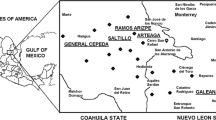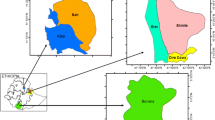Summary
An investigation was made of the seasonal incidence of coccidial infection in West African Dwarf (WAD) goats in 2 villages and an on-station situation in the subhumid zone of Nigeria. Faecal samples were obtained from about 70 goats in each village and 160 on-station at 4 times of the year, early and late dry and wet seasons.
Six species ofEimeria were found to occur;E. arloingi, E. apsheronica, E. pallida, E. alijevi, E. jolchievi andE. ninakohlyakimovae which accounted for 18, 16, 22, 9, 24, and 11% of infections respectively. Overall rates of infection were very high, averaging approximately 87%, and peaked during the late wet season, when the proportion of heavy infections also increased significantly. At this time the proportion of infections classified as heavy was significantly higher in the village goats than the on-station goats, and was also significantly higher in kids than in adults. Clinical disease only occurred in kids. The potential benefits of controlling such infections in terms of productivity responses appear worthy of further investigation in these farming systems.
Résumé
La recherche de l'incidence saisonnière de la coccidiose a été effectuée chez des chèvres naines d'Afrique de l'Ouest dans deux villages et en station dans la zone subhumide du Nigéria. Des prélèvements de fèces provenant de quelque 70 chèvres dans chaque village et 160 en station ont été faits 4 fois par an, en début et fin de saisons sèche et humide. Six espèces d'Eimeria ont été trouvées:E. arloingi, E. apsheronica, E. pallida, E. alijevi, E. jolchievi etE. ninakohlyakimovae qui représentaient respectivement 18, 16, 22, 9, 24 et 11 p. 100 des infections. Le taux global de l'infection était très élevé, environ 87 p. 100 en moyenne, et atteignait son maximum en fin de saison humide, lorsque le taux de parasitisme massif augmentait significativement. A ce moment la proportion des infections considérées comme massives était significativement plus élevée chez les chèvres villageoises que chez celles en station et était aussi significativement plus élevée chez les chevreaux que chez les adultes. La maladie clinique apparaissait seulement chez les chevreaux.
Resumen
Se realizó una investigación sobre la incidencia estacional de infecciones por coccidia en cabras Dwarf (CD) en 2 villas y en una estación experimental en la zona semihúmeda de Nigeria. Se obtuvieron muestras fecales de 70 cabras en cada villa y 160 en la estación experimental, 4 veces en el año, al principio y al final de la estación seca y lluviosa.
Se encontraron seis especies deEimeria; E. arloingi, E. apsheronica, E. pallida, E. alijevi, E. jolchievi yE. ninakohlyakimovae las que fueron la causa de 18, 16, 22, 9, 24 y 11% de infecciones respectivamente. Las tasas de infección generales fueron altas, promediando 87% aproximadamente, alcanzando el máximo pico al final de la estación lluviosa, cuando la proporción de infecciones se incrementó significativamente. En este momento las infecciones clasificadas como graves se presentaron más en las cabras de villorrio que en aquellas de la estación experimental, siendo también más graves en los cabritos que en los adultos. La enfermedad clinica solo se vió en los cabritos. La posibilidad de controlar la infección en términos de productividad, parece plausible de investigaciones adicionales en aquellas sistemas de crianza.
Similar content being viewed by others
References
Adewuyi, A. A., Sannusi, A., Kyewalabye, E. K. &Akerejola, O. O. (1989). Prevalence of coccidial infections among sheep flocks in Zaria, Nigeria.Journal of Animal Production Research,9, 85–95.
Akerejola, O. O., Veen, T. W. S. &Njoku, C. O. (1979). Ovine and caprine disease in Nigeria. A review of economic losses.Bulletin of Animal Health and Production in Africa,27, 65–70.
Benbrook, E. A. &Sloss, M. W. (1948).Veterinary Clinical Parasitology. Iowa State University Press, Ames, Iowa, USA.
Fabiyi, J. P. (1980). Ovine coccidiosis in Nigeria. A study of prevalence and epidemiology of infections on the Jos Plateau and environs.Bulletin of Animal Health and Production in Africa,28, 21–25.
ILCA (1984).ILCA Annual Report. IlCA, Addis Ababa, Ethiopia. pp 18–19.
Jahnke, H. E. (1982).Livestock production systems and livestock development in Africa. Kieler Wissenschaftsverlag Vauk, Kiel.
Lee, R. P. &Armour, J. (1959). The coccidial oocysts of northern Nigerian cattle.British Veterinary Journal,115, 6–17.
Majaro, O. M. &Dipeolu, O. O. (1981). The seasonal incidence of coccidia infections in trade cattle, sheep and goats in Nigeria.The Veterinary Quarterly,3, 85–89.
Snedecor, G. W. &Cochran, W. G. (1967).Statistical Methods. 6th ed. Iowa State University Press, Ames, Iowa, USA.
Souslby, E. J. L. (1982).Helminths, Arthropods and Protozoa of Domesticated Animals. 7th ed. Baillière Tindall, London.
Thompson, J. G. &Hall, G. N. (1931). Observations on intestinal coccidiosis of sheep in Nigeria.Journal of Tropical Medicine and Hygiene,34, 369–373.
Author information
Authors and Affiliations
Rights and permissions
About this article
Cite this article
Woji, A.Y., Little, D.A. & Ikwuegbu, O.A. Prevalence of coccidial infections in the west African Dwarf goat in the subhumid zone of Nigeria. Trop Anim Health Prod 26, 1–6 (1994). https://doi.org/10.1007/BF02241123
Accepted:
Issue Date:
DOI: https://doi.org/10.1007/BF02241123




